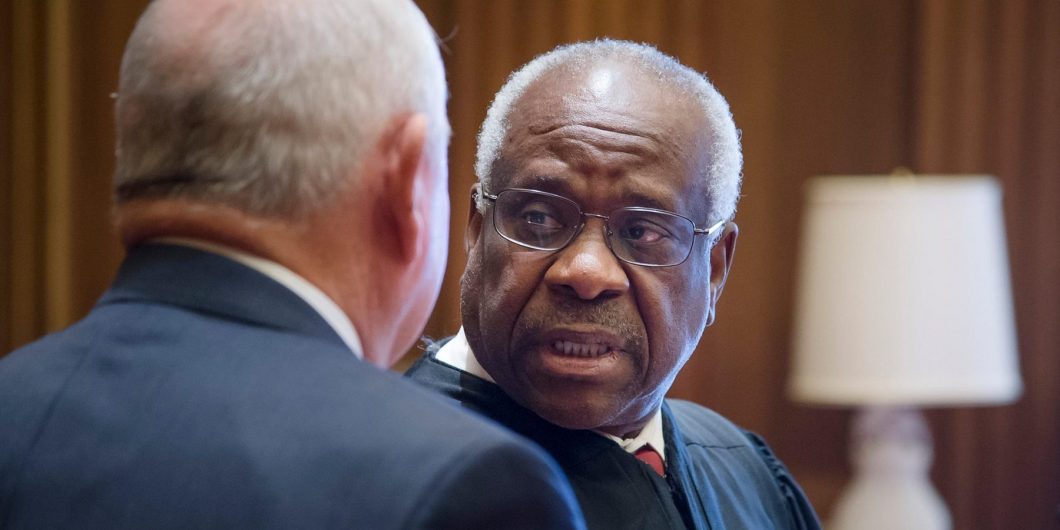Originalism must construct rules of precedent that mediate between the value of following the original meaning and the value of constitutional settlement.
Why Justice Thomas Is Wrong about Precedent
This term Justice Clarence Thomas wrote an important concurring opinion on stare decisis in Gamble v. United States, the case on the scope of double jeopardy. There Thomas rejects stare decisis for both constitutional and statutory cases except in cases where the precedent is not “demonstrably erroneous.” Thomas recognizes that judges in England at the time of the Constitution applied a more robust doctrine of stare decisis, but rejects the notion that federal judges have the authority to follow a similar doctrine today in statutory and constitutional cases. For Thomas, the difference is that English common law was judge-made, but “we operate in system of written law in which courts need not—and generally cannot—articulate the law in the first instance.”
The problem with Thomas’ historical argument is that judges in England also interpreted written law in the form of statutes. And parliamentary supremacy debarred them from “articulating the law in the first instance” in that context as well. Nevertheless, English courts regularly applied stare decisis to matters of interpreting the written law of statutes. Thus, it is not true that the change to written law put the traditional use of stare decisis outside the scope of judicial power that judges possess according to Article III.
Here are a few examples of stare decisis in statutory cases from English case law in the decades before the Constitution. In Lloyd v. Tench (1750) the question was whether a niece, nephew and aunt should take per stirpes (where each branch of a family gets an equal share of inheritance) or per capita (where each person gets an equal share). A statute governed the appropriate distribution in the absence of a will. The Master of the Rolls, Sir John Strange, noted that the advocates had failed to cite prior law, but that a series of cases interpreting the statute made clear that all individuals should take an equal share. “After two such authorities, the question is at peace and could I entertain a doubt in my own mind (which I do not) I should think myself bound by stare decisis.” Similarly, in the 1754 case of Parker v. Drew, the King’s Bench decided on the basis of stare decisis and did not consider anew the way to interpret a statute that relaxed the requirements of a habeas question.
Moreover, judges yielded to prior precedent in statutory interpretation even when they thought the previous cases were decided incorrectly. In Ellis v. Smith (1755), the question was whether a testator’s declaration before three witnesses that it was his will and testament is equivalent to his signing the will to make it effective under the statute of frauds. Precedent favored that proposition. As Sir John Strange stated “The case . . . has been considered at so many times and has so many authorities that it may be considered as settled.” Sir John went on to say “Yet I think it a dangerous determination, and destructive of those barriers the statute erected against perjury and frauds.” Other judges in the case, including Chief Baron Parker and Chief Justice Willes, also suggested that they might have come out the other way but for the precedent.
Finally, in Bishop of London v. Fytch (1762), the great Lord Mansfield acquiesced in interpretation of the statute of simony which permitted people to be admitted to benefices even if they had given their bond to resign whenever their patron asked them to do. That assurance seems quite against the purpose of the statute against the buying and selling of ecclesiastical privileges, and Mansfield recognized that much could be said against it. “But,” he continued “it cannot now be argued. We are bound by the decisions if we thought them ever so wrong.” (emphasis added).
Thus, because English courts did apply rules of precedent to statutes, Thomas has not rebutted the powerful argument that the Constitution does not displace the authority of the federal judiciary to apply precedent to written enactments, including the Constitution. Thomas does not dispute that the federal courts can apply precedent in cases of federal common law, like admiralty law. That authority comes from the same place from which comes the authority to apply precedent to written law—the judicial power. This legal term in Article III gives judiciary the traditional authority exercised by judges, which included the authority to apply precedent to written law. Indeed, Thomas acknowledges that the judicial power permits him to follow precedent that is not demonstrably erroneous if he believes it is not the best interpretation of the Constitution.
To be clear, precedent as applied to the Constitution would not be here displacing the higher law of the Constitution any more than it had displaced statutory law. It would simply govern how the judiciary decides what law is, at least in the absence of precedent rules established by the legislature.
Nor would constitutional precedent likely look like the strong form of precedent that English courts applied to the statutory decisions. Because precedent is a common law doctrine, courts can and should consider the relevant differences between the Constitution and ordinary legislation in deciding what precedent to apply. One salient difference is that the Constitution is far harder to amend and thus it is harder for the people and their representatives to modify the results of the Supreme Court’s interpretation of a constitutional rather than a statutory provision. The Court’s current precedent rules are rightly stronger for constitutional decisions that for statutory decisions. One of the oddities of Thomas’s position is that for him, it makes no difference whether a statutory or constitutional case is up for reconsideration.
In Mike Rappaport’s and my view, precedent rules should indeed be less protective of wrong constitutional decisions than they have become in the modern era. Currently, the court has an effective presumption in favor of precedent. But that presumption gives insufficient weight to the benefits of following the original meaning. The Court has also applied the doctrine inconsistently, as a majority effectively dispenses with this presumption on an ad hoc basis when it wants to overrule an opinion. Moreover, by extending this presumption to precedents that make no bona fide attempt to even locate the relevant original meaning (I am talking about Roe v. Wade, among others), it reduces the incentive to write originalist opinions in the first place. The results-oriented nature of the current doctrine of stare decisis and its failure to encourage judicial fidelity to the original meaning provide powerful reasons for modifying the doctrine.
The question of how to frame precedent rules that make the optimal tradeoff between the traditional values of precedent and following the original meaning in constitutional cases is a difficult one. Rappaport and I have begun but not finished that kind of inquiry. But whether you agree with the rules we have proposed or not, that tradeoff is the essential question. Thomas’s dismissal of common law precedent in the context of written law is a distraction, based on a misreading of history.


